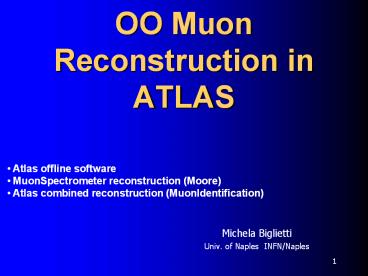OO%20Muon%20Reconstruction%20in%20ATLAS - PowerPoint PPT Presentation
Title:
OO%20Muon%20Reconstruction%20in%20ATLAS
Description:
OO Muon Reconstruction in ATLAS Atlas offline software ... RPC/TGC/MDT digits Moore Ntuples Tracks Easier integration with other ATHENA packages to ... – PowerPoint PPT presentation
Number of Views:121
Avg rating:3.0/5.0
Title: OO%20Muon%20Reconstruction%20in%20ATLAS
1
OO Muon Reconstruction in ATLAS
- Atlas offline software
- MuonSpectrometer reconstruction (Moore)
- Atlas combined reconstruction (MuonIdentification
)
- Michela Biglietti
- Univ. of Naples INFN/Naples
2
Offline software in Atlas
Necessity of a framework a template application
into which developers plug in their code, using
mechanisms defined by the framework, collections
of functionality, common vocabulary
Athena
3
Offline Reconstruction in Atlas
Algorithm
Event
Event
T D S
Alg1
Event
Algorithm
Event
Alg2
Event
Algorithm
Event
Alg3
Event
Atlas
Raw digits
Data flow
MC simulation
Tracking
Tracks
Detector Description
E/g identification
Event, Identified particles
Em cluster
Calorimetry
Calo Jets
Combined Muon
Muon
Analysis
Muon
4
Moore in Athena
Moore
Tracks
Before
RPC/TGC/MDT digits
Ntuples
MooAlgs
RPC/TGC digits
MooMakePhiSegments
- Each step is driven by an Athena top-algorithm
- Transient objects are passed via TDS/StoreGate
- Independent algorithms, the only coupling is
through the transient objects
MooLVL2PhiSegmentMaker
PhiSegments
MooMakeRZSegments
MooLVL2RZSegmentMaker
MDT digits
MooMakeRoads
CrudeRZSegments
MooMakeiPatTracks
MooRoads
MooStatistics
MooiPatTracks
Results less dependencies, code is more
maintainable, modular, easier to develop new
reconstruction approaches
Easier integration with other ATHENA packages to
get services and for combined reconstruction,
test-beam software, calibration, online/EF sw
MooMakeNtuples
Ntuples
5
Moore Packages
Athena algorithms with different features/goals
MooAlgs_2
MooAlgsLVL2
MooAlgs
MooStatistics
MooAlgs_n
MooCode
Shared code used by Athena Algos
MooEvent
Events for reconstruction
6
Performance
Single muon studies
Efficiency vs Pt
A Muon track consists ofhits from at least 2
stationsand is successfully fitted.
PT (GeV)
PT 100 GeV
PT 20 GeV
? 3.3
? 3.4
Pt resolution
7
Speed
- MOORE
- Pentium III 850 MHz - 256 Mbytes
MUONBOX
Pt(Gev) Time(ms)
20 90
100 300
300 570
1000 1500
8
Combined Muon Reconstruction
- Improve muons identification efficiency
- Discrimination of muons from ? rays in the muon
spectrometer - Reconstruction of low energy muons that do not
reach the middle and outer stations of the muon
spectrometer - Rejection of decay muons (from k and ?) by
requiring tracks originate close the interaction
point - Discrimination of muons in hadronic jets from
hadrons. An efficient muon b-tagging requires
a good muon identification for non isolated muons
- Improve track parameters
- Achieve the best possible momentum resolution
- Reduce tails in the momentm resolution of the
muon spectrometer, resulted from fluctuation in
energy loss in the calorimeter - Improve charge determination for high energy
muons - Understand the detector
- Check the calibration of calorimeter.
- Cross check the results from the inner detector
and muon spectrometer (for muons with momenta
from 20 GeV to 70 GeV)
9
Muon Identification
- Pre-existing work Muon Identification (MUID)
package used for physic TDR - Atrecon implementation
- Input results of ID, Calo and Muon
reconstruction (Muonbox) (as C objects through
interface packages) - Output class structure gt zebra banks gt
combined ntuple - Purpose associate tracks found in Muon
Spectrometer with inner detector (ID) tracks and
calorimeter information to identify muons at
their production vertex with optimum parameter
resolution - 2 principle methods
- Stand-alone muons Muon Spectrometer track and
track-segment parameters propagated to beam-axis - MS track and inner station segment parameters
propagated to beam-axis - Angle resolutions dominated by Coulomb scattering
in calo - Parametrise calorimeter effects function of p
and h (i.e. thickness) or measure energy loss
from calibration of observed energy deposition - MS track is express at vertex
- Combined muons match Muon Spectrometer to ID
tracks and fit combined parameters - ?2 cut for matching of inner detector and muon
spectrometer tracks parameters - combined fit
10
Muonidentification Athena Implementation
Algorithms
TDS
MuidInit
Moore Tracks
TruthEvent Tracks
MuidStandAlone
MuidTracks status muon
CaloClusters
MuidComb
MuidTracks status standalone
MuidNtuple
ID Tracks
MuidIDNtuple
MuidCombNtuple
MuidTracks status combined
Ntuples
11
Energy loss in the Calorimeters
reconstructed (GeV)
Total energy loss
Tile
from MC-Truth (GeV)
Endcap hadronic LAr
EM LAr
12
StandAlone Tracks pulls _at_vertex
Single ? Pt 20 GeV
F pulls
cotq pulls
13
Pt corrections _at_vertex
Pt 20 GeV
Pt 100 GeV
Pt _at_MS entrance (Moore)
Pt _at_vertex
Pt _at_MS entrance (Moore)
Pt _at_vertex
14
Pt Resolutions Combination
Muon Track (Moore Calo Muid)
InDet (iPatRec)
Combined (Muid)
Pt 300 GeV
Pt 100 GeV
Muon Track (Moore Calo Muid)
? 2.9
? 3.9
InDet (iPatRec)
? 5.2
? 12.5
Combined (Muid)
? 3.8
? 2.6
15
Conclusions
- Moore
- What is needed
- Description of inert material
- EDM implemantation
- Layout P DC1 data reconstruction
- Items
- Material, EDM, testbeam version, geometry/event
description, repackaging/intergration, LVL2 - MuonIdentification
- to do
- Energy loss parametrisation
- Fit-tracking optimization
- Calorimeter multiple scattering tuning
- Integration with the new version of Moore
(material description and EDM) - Better design, full debug































